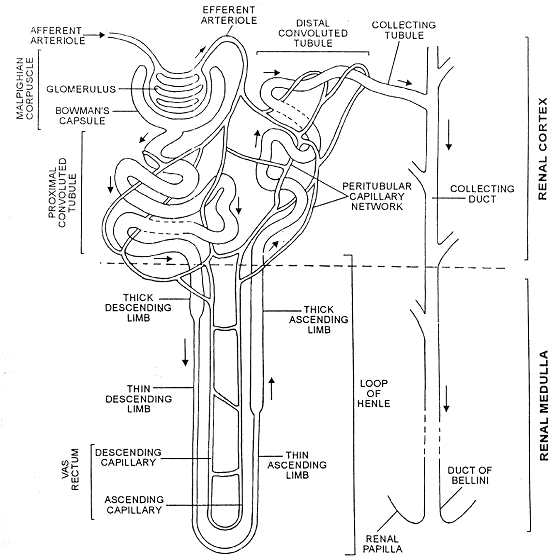URINIFEROUS TUBULE -
Unit of kidney. 3-5 cm. long (30 mm). Total length of nephrons is 65 km.
A tubule consists of -
1. Malpighian capsule
(i) Bowmanns' capsule (ii) Glomerulas
2. Neck
3. Secretory tubules
(i) PCT (ii) Henle's loop (iii) DCT (iv) Collecting duct
1. MALPIGHIAN CAPSULE -
Head part of nephron. Situated in cortex part. In contains U-shaped Bowmann's capsule.
Interior porous layer is of podocytes having minute out grwoth as Trabeculae.
Due to pores permeability of membrane is increased 100 to 1000 times.
In Bowmann's capsule glomerulus present having mesenseal cells.
Glomerulus is formed by afferent and efferent arterioles. Diameter of afferent one is more than efferent.
Both arterioles form network of capillaries. Diameter of malpighian capsule is 0.2 mm.

2. NECK
Connection between head and tubule. Internally lined by cilliated epithelium.
3. SECRETORY TUBULES - (i) P.C.T. -
Starting part of tubule. Situated in cortex. Generally lined by cuboidal epithelium.
Microvilli present increases surface area for reabsorption & helpful in phagocytosis.
(ii) Henle's loop -
It is U-shaped. One arm is descending & another is ascending.Situated in medulla.
Descending arm is less thicker than ascending arm.
Interiorly lined by squamous epithelium, microvilli are small.
(iii) DCT - Situated in cortex. Interiorly lined by cuboidal epithelium. Microvilli absent.
(iv) Collecting duct - Present in medulla. Interiorly lined by columnar epithelium. Collecting ducts combine to form Duct of Bellini.
Note :- Cortex is made up of malpighian's capsule, PCT, DCT. Medulla is made up of Henle's loop, collecting duct.
Efferent arteriole runs parallel to Henle's loop to form vasa recta or reta mirabile. It in the end form renal vein.
Nephrons are of 2 types -
1. Cortical Nephron (80%) - Bowmenn's capsule are close to kidney's surface. Henle's loop are small.
2. Juxta medullary nephron (20%) - Henle's loop - large